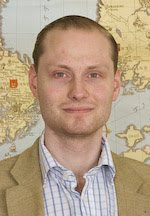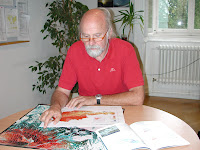Menschen im Gespräch: Teil III
Interview
Fil. cand. Fredrik Charpentier Ljungqvist
Fredrik Charpentier Ljungqvist is Secretary for the Centre of Medieval Studies at Stockholm University and PhD student at the Department of History at Stockholm University (http://www.medeltid.su.se). One of his publications is listed in the branch NOAA Palaeoclimatology/Climate Reconstructions (Climate Reconstructions) on the famous side of the NOAA's National Climatic Data Center (NOAA Paleoclimatology Program).
I am talking about the paper "Temperature Proxy Records Covering the Last Two millennia: a tabular and visual overview", which I have already mentioned (see the interview with Dr. Böhm.) Unfortunately you can only find the abstract and the data in txt-format (downloadable [txt-format, 1,3 MB], here: Temperature Proxy Records ...) but not download the paper as a whole as a pdf-file. I think this paper is very important and the reason for making this interview. Mr. Ljungqvist also published a book on climate changes during the last 10,000 years, and its inpacts on human history in Swedish last year at Sweden's major publishing house (Global nedkylning - Klimatet och människan under 10 000 ar).
I am talking about the paper "Temperature Proxy Records Covering the Last Two millennia: a tabular and visual overview", which I have already mentioned (see the interview with Dr. Böhm.) Unfortunately you can only find the abstract and the data in txt-format (downloadable [txt-format, 1,3 MB], here: Temperature Proxy Records ...) but not download the paper as a whole as a pdf-file. I think this paper is very important and the reason for making this interview. Mr. Ljungqvist also published a book on climate changes during the last 10,000 years, and its inpacts on human history in Swedish last year at Sweden's major publishing house (Global nedkylning - Klimatet och människan under 10 000 ar).
____________________
W.v.B.: Mr. Ljungqvist, I am very glad and thankful for giving me the opportunity to conduct this interview with you. Could you please start with a short introduction. What was the starting situation and what did you do? On a second step you may answer the question, if you have found evidence for the existence of a Medieval Warm Period in Scandinavia, in the proxy data you added (Dalmutladdo, Lake Toskaljavri, Lake Tsuolbmajavri, Abisko Valley, Torneträsk, Lake Sjuodjijaure, Soylegrotta, Jämtland, Lake Spaime, Lake Laihalampi and Lake Flarken) or not.
F.C.L.: My paper, "Temperature proxy records covering the last two millennia: a tabular and visual overview", was a review of available palaeotemperature proxy records from around the globe going back (at least) 2,000 years. All in all, 71 records were presented, visualized and discussed. (There area great many shorter records out there). The purpose with the work was to offer a good review of the data available of temperature changes in the last two millennia. Even for scholars in the field, it is easy to miss some records, and hence the need for a good review.
There are defiantly many evidences for the MWP in Scandinavia. From all sorts of data: tree-ring width and density, glaciological evidences, lake sediments, pollen records, stalagmites, lake varves and so on.
W.v.B.: What were the results for Europe and the Northern Hemisphere?
F.C.L.: It is most easy to firmly state the existence of the MWP on Greenland and in China. (The proxy data for China are actually better than for Europe.) The MWP is perhaps most clear there but we see it in almost all records from around the Northern Hemisphere, except for in a few drought-affected tree-ring records. So to answer your question, there was a warm period in both Europe and the Northern Hemisphere as a whole sometime between AD 800 and AD 1300 followed by generally cooler conditions until the 1900s. The peak of the MWP seems to have occured, in most places, just prior to AD 1000.
W.v.B.: Do you think that the MWP was a global phenomenon?
W.v.B.: Would you finally please summarize the gained results and your opinion on the existence of a MWP for my readers.
F.C.L.: Most likely, the MWP was one of the many warm climate cycles during the last 10,000 years. Those climate cycles, with a multi-centennial warm period approximately every 1,000-1,500 year, are often called "Bond Cycles" and are of still unknown origin although changes in solar forcing probably play a part. The MWP is a historical reality. The 10th and 11th centuries were, most probably, at least as warm as the 20th century as a whole.
W.v.B.: I want to thank you for being my interview partner. I wish you continued good luck and still another beautiful summer.
F.C.L.: Have a continued good summer yourself!
copyright W.v.B.

